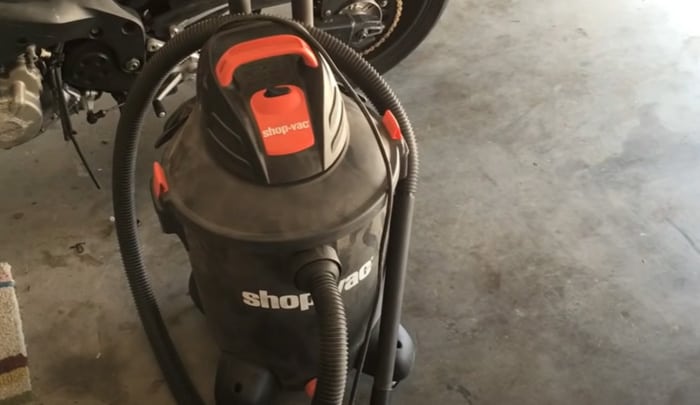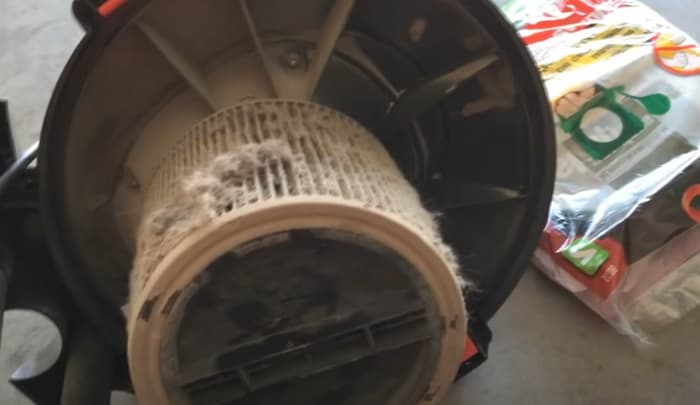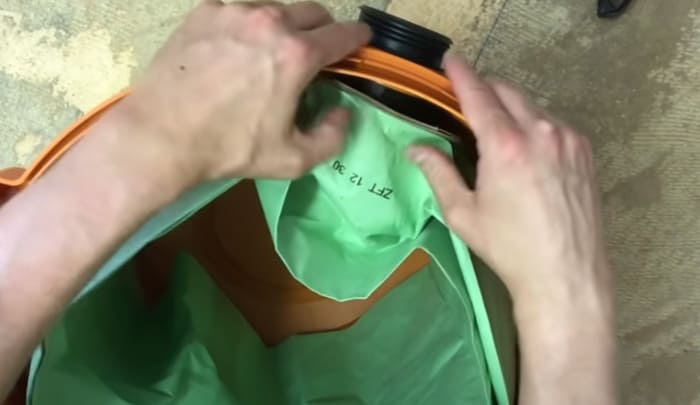
A shop vac is often the unsung hero of various home improvement projects, as well as daily cleaning. From sawdust to spilled drinks, this vacuum cleans up everything possible. Yet while doing so, the vacuum itself inevitably gets dirty. Having a clean vacuum filter and an unblocked intake of air helps your vacuum to perform at its full functionality, so be sure to maintain your vacuum regularly. Unmaintained vacuums can lose up to 60% of their performance and may even start to smell. Not sure how to maintain your vacuum? Read on for some tips and tricks to ensure that your vacuum is in good shape.

To clean a vacuum filter, first you have to disassemble your vacuum machine. Tap the filter to remove the dust and debris. Wash it with soap and water. Clean the rest of the device. Finally, Put it all back together. Don’t forget to read the manual provided by the manufacturer.
Get all the tools for the job
Here’s what you’ll need, in order to clean up your vacuum:
A large container or trash can so that you can store the dirt from the vacuum. It’s best to choose one with a lid to prevent the dust from spilling out. Two removable caps used to hold the filter ends. Large nail or rod with an attached head to hold the filter and caps while you clean. Plastic lid to protect against dust, a hose, air compressor (If this isn’t available, using compressed air will also work), safety goggles, and N95 or similar mask.
Disassemble Your Vacuum
You should be warned that the steps listed will not involve washing the filter, and works best for standard cartridge filters of a cylindrical shape. This is likely the most common type of filter used in many vacuums.
Given that these filters have paper parts in them, it is not suitable to be washed in water. If you insist on using water to clean your filter, it is best to double-check with the manufacturer if doing so will void any warranty or damage your vacuum.
What you should first do is unplug the power cord. After all, you wouldn’t want to run the risk of electrocution while cleaning.
Next, you should proceed to disassemble your vacuum. This will allow you access to the inner parts of the vacuum, including the filter. Most vacuums are not complicated to disassemble, but when in doubt, you should always refer to the manual that came with your vacuum during purchase.
Be gentle when you disassemble the vacuum, making sure not to break any parts as they could be costly to replace, or even unavailable if your vacuum is rather old. You’ll then want to remove the filter and place it in a large container. This is also a good opportunity to check for any bed bugs in your vacuum cleaner, especially if you’ve recently dealt with an infestation.
Remove the filter
If you have the option to do so, you should always clean your filter outdoors. This is especially important if it’s been a while since you cleaned the filter since dust will likely be produced during the cleaning process that could dirty your other indoor items. Prior to the cleaning, you should also wear safety goggles and a mask to protect yourself against dust irritation.
You’ll want to place the filter inside your trash can or container, and cover it with a plastic lid. This helps to ensure that the dust and debris dislodged from the filter remains contained in one place, making it easy to dispose of. It’s important that you get a lid that has a hold for your hand to go through, allowing you to hold the filter to tap it and dislodge the debris.
The tapping should be repeated for about 5 to 10 minutes until most visible debris has dropped off from the folds. Turn the filter around while doing so to ensure that debris from all sides is taken care of. The unwanted debris will fall to the bottom of your chosen receptacle. You can then easily dispose of this debris in the trash.

Clean out pleats
You can use a steel or plastic brush to clean out the pleats of your filter. This should take care of the smaller debris that was not being dislodged by tapping the filter against the trash receptacle. Another way to do so is to use a plastic putty knife to get to the gunk. Be sure to only use gentle force, as you don’t want to damage the pleating.
Use compressed air
Ensuring that your filter is closed on both ends with a cap, and a 10 inch nail or road is put through it to allow it to rotate, you can move on to using compressed air to clean.
If you are using an air compressor, attach it to the hose, and blow the air at it while your filter spins in place since it’s held up by the rod or nail. The high-speed air blowing will help to further get rid of smaller dust particles that were not removed in the earlier steps. For better results, you might want to spin the filter slowly, to allow the compressed air to reach every layer of the filter.
If you don’t have an air compressor, just buy a compressed air can. These are very cheap, costing only $7 dollars.
As this action will definitely cause a dust cloud, it is important that you stand upwind to avoid inhalation of the dust particles. You should also put on safety goggles and a dust mask to prevent irritation caused by dust.

Wash filter with warm water
If you must wash your filter, then do so in warm soapy water. You can consider adding in 1.5oz of dish soap, as it helps to get rid of grease especially if you’ve used the vacuum on oily or greasy items. Allow the filter to soak for 15 minutes, before hosing off the soap. Ensure that the filter is completely dried before reassembling it.
Washing of the filter should only be done if your filter does not have paper parts, or if you have exhausted all other methods but it is still significantly dirty. If you’ve been dealing with bed bugs, make sure to follow specific cleaning procedures for your vacuum.
Extend the life and suction power of your vacuum cleaner
With that all said and done, if you, unfortunately, destroy your filter, don’t worry too much since the shop vac can still be used without a filter. It’s just less safe to do so.
Shop-Vac filters can last up to a year before they need to be replaced, though if you use them often, then you should consider changing them out after 6 months so your vacuum remains strong and powerful. If you notice your upright vacuum is hard to push, it might be time for a filter change or maintenance. Remember, if you use other types of shop vac filters and are in doubt, then you should always consult your owner’s manual.
“In my years of servicing vacuums, I’ve found that maintaining your shop vacuum’s filter is not a one-size-fits-all task. Generally, clean your filter after every major cleanup or sooner if it’s particularly dirty – trust me, your vacuum’s performance will improve greatly.”
Zakariah ‘Zack’ Thackery, Vacuum Service Specialist
Refences
https://www.vacuumsguide.com/vacuum-cleaner-filters/
https://www.moglix.com/articles/what-are-the-uses-and-purpose-of-vacuum-cleaners





The importance of regular vacuum maintenance cannot be overstated. During my early years as a handyman, I quickly learned that keeping your tools, even as mundane as a vacuum, in top condition could save you a lot of time and unnecessary headaches down the line.
I have been diligently cleaning my shop vac every week for the past 15 years and it’s still as good as new. So I can vouch for how important maintenance is when it comes to ensuring these machines retain their optimum performance levels.
It’s surprising how many people don’t appreciate the importance of maintaining their shop vacs, I clean mine bi-weekly and have noticed a significant improvement in its efficiency and lifespan.
I couldn’t agree more, Cyrus. I used to have this same problem with my shop vac, not realizing the importance of regular maintenance until it broke down on me in the middle of a project. It’s interesting to see how something as simple as a clean filter and an unblocked air intake can greatly increase a vacuum’s productivity. Now, I spend a few minutes every week checking and cleaning out my shop vac, and I’ve seen a remarkable difference in its performance.
Having supervised a maintenance team in an industrial setting, I can’t stress enough the importance of regular cleaning and maintenance of machines. It’s tempting to ignore the said routines with small machines like shop-vacs, but it can lead to equipment failure in most unfortunate times. A few minutes of your weekly time spent on upkeep can save you from hours of frustration later.
Couldn’t agree more with Vernon Northwood. Maintaining your shop-vac is akin to car maintenance, you wouldn’t drive your vehicle for thousands of miles without checking the oil or changing the tires, would you? The same logic applies to your shop-vac; neglect it and it’s bound to malfunction at the most inconvenient time.
Just like Quincy said, maintaining your shop vac is vital for its longevity. I once forgot to clean the filter on my old one after drywall sanding and it burnt out a week later. From then on, I made sure to check and clean it after every heavy-duty use.
Speaking from my own experience, failing to replace your vacuum filter after every heavy-duty project can lead to all sorts of trouble – I lost a nearly new model this way after a big drywall job.
Gilbert’s got it right — not changing your shop vac filter can indeed be a mighty expensive mistake! Long story short, once sawdust gets compacted in those filters, it’s more stubborn than blue norther on a cold Texas morning!
Changing a shop vacuum filter was a task I frequently neglect until dust allergies hit me so hard that I needed to see my doctor – it’s not just about maintaining the equipment’s functionality but also protecting your health!